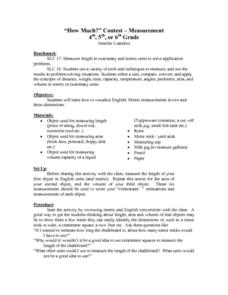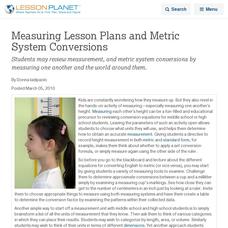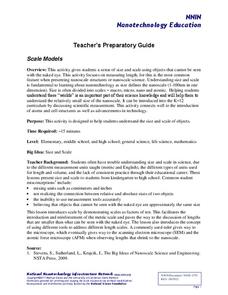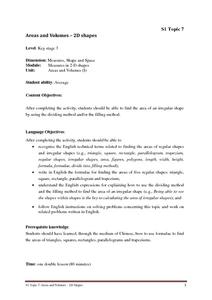Curated OER
Tree Measurement
Measure a tree? Yes, measure a tree! Students get outside and measure a tree's trunk, crown, and height. Each group compares their answers to determine if any re-measuring is necessary. Once back in the classroom, students make bar...
Teacher's Corner
What Is a Foot?
An in-class and at-home assignment, young math stars find and list items from home and school that they think are one foot in length. Once the list is made, provide everyone with rulers to measure and find the actual lengths of their items.
Curated OER
Metric Conversions
Students measure an assortment of items using metric measurements. In this measurement lesson, students measure using length, mass, and volume units of measurement. They convert between units. Students learn a mnemonic to assist in...
Curated OER
English Measurement System
Students determine how to convert measurement. In this English Measurement instructional activity, students discover interesting facts about the history of measurement. Students study formulas and practice using them.
Curated OER
Measuring Up!
Students draw lines of certain lengths by using appropriate measuring tools. In this measurement lesson plan, students determine which measurement tools would be best to draw specific lengths to make a barn.
Curated OER
Learning to Measure
Fourth graders explore measuring with English unit rulers. They practice measuring in fractions of inches. Students discuss how to place the ruler when measuring an object. They begin measuring using rulers with 1/4 inch increments and...
Curated OER
Comparing Measurements
Students explore measurements by completing worksheets in class. In this geometry lesson, students identify the basic measurement units in both the English and metric systems. Students analyze 2 and 3 dimensional objects and identify...
Curated OER
Measurement Conversion
In this measurement worksheet, students convert 10 metric units of measurement to standard or English units for liquids, mass, and length. This worksheet is printable and no answers are available.
Curated OER
"How Much?" Contest - Measurement
Students work with measurements of length, area, and volume capacity of a liquid. They watch a teacher demonstration of both English and metric units before they estimate and take actual measurements of assigned items a three different...
Curated OER
Measuring Lesson Plans and Metric System Conversions
Students may review measurement, and metric system conversions by measuring one another and the world around them.
National Nanotechnology Infrastructure Network
Scale Models
With instructions to adapt the activities for any grade K-12, any teacher can incorporate the concept of scale into the classroom with a simple, yet effective lesson.
Curriculum Corner
Area and Perimeter
Get third graders excited to work find area and perimeter of unit squares, rectangles, and irregular shapes. A 36-page packet comes with task cards, graphic organizers, practice worksheets, printables with squares, exit tickets, and word...
Curated OER
Addendum to the Written Curriculum: Measuring Solids
Students use standard rulers to measure the length of common classroom items - such as pencils, books, desk tops - in inches and centimeters, and measure weight in pounds. They also answer math questions, such as "How long is the front...
Curated OER
Conversion Math
In this conversion worksheet, students find the corresponding length or weight for each measurement given using the conversion chart given. Students complete 4 problems.
Government of Hong Kong
Areas and Volumes - 2D Shapes
Unfortunately for young mathematicians, the world isn't made entirely of parallelograms, triangles, and trapezoids. After first learning the area formulas for these common shapes, students apply this new knowledge to determine the area...
Curated OER
Leaping Lemurs! How far can you jump?
Learners watch a segment of the PBS video which show the lemurs' ability to jump. In pairs, students collect measurement data involving each other's length of a standard step, a standing broad jump, and a long jump. They record their...
Curated OER
Metric Conversions
Students practice the fundamentals of converting metric measurements. They translate a mathematical idea from one form to another and compare and convert a given measurement to another unit within the same measurement system. Students...
Curated OER
The Metric System
Students convert measurements within the metric system. In this measurement lesson, students explore the different units of the metric system and practice converting numbers from one unit to another.
Curated OER
Average Looking
Students use measurements of their classmates to find the average (means and modes) of their facial features. They use their findings to create a three-dimensional "class head." Examples and assessment materials are included.
Curated OER
Cartography Project
A activity involving mapping, the use of a compass, writing and following directions, and exploring the first two themes of geography is here for you. Learners create original maps that show the routes they take through their own...
Curated OER
Metrically Me!
Students define the parts of a database, search strategies to locate information electronically, create/modify databases, etc. and enter data into a prepared spreadsheet to perform calculations.























